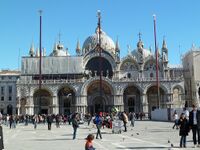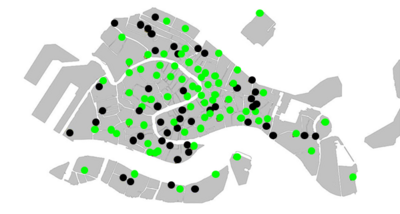Churches
 |
Churches, or chiese in Italian, are a common feature in most squares, or campi, throughout the city of Venice. 139 churches are visible in the city's skyline, including a few recognizable landmarks, such as Church of Frari, Church of Miracoli, and the Basilica of San Marco (Church) pictured on the right. Some of the larger churches have become tourist attractions in the city of Venice. The most commonly visited church is Basilica of San Marco (Church), however many others are open to the public daily. Several churches are open for free or ask for donations, however 16 are run by the Chorus, an organization that is responsible for the maintenance of select churches in the city, charges a small fee for entrance. While there are 139 church buildings in the city of Venice, only 88 of them are still practicing churches that hold mass at least once a week. The other 51 churches have been converted to other uses such as schools, museums or storage facilities. The graph below shows the location of the 88 practicing churches in Venice, not including the 12 located on the Lagoon islands.

History
One of the reasons Venice has so many churches is that each community in the city built its own place of worship, usually as a way of bringing the community together. Churches were often funded by wealthy merchants to showcase their wealth, by constructing dramatic interiors or elaborate façades. The oldest churches in the city were first established in the 9th century. While these church buildings are no longer standing, their traditions have continued through the years. In addition of old age, the churches of Venice have been subject to many disasters. In both the 11th and 15th centuries, fires burned through the city, destroying nearly all the buildings in their path. In the 15th century, the great fire in San Marco burned 21 churches to the ground. [1]
Another event in Venice’s history that affected many of the churches was Napoleon Bonaparte’s occupation of the city. In 1797, Napoleon took control of the Republic of Venice, and proceeded to suppress many churches and converts. Many of the churches he suppressed were able to reopen a couple of years later, however several were converted to military barracks or warehouse facilities and have not been restored to their original condition. [2] Napoleon also ransacked several of the churches, and sold the art work that hung on their walls. Whether it has experienced one of these examples of city wide events, every church in Venice has a unique story to share.
Church Floors
Floors are generally the last place someone looks for art, but in Venice, this is hardly the case. 74 of the 139 churches of Venice contain 2221 floor artifacts categorized as either tombs or plaques. [3] These Church Floor Artifacts contain valuable information in their inscriptions that provide a glimpse into the Venetian history. Several churches contain tombs of Doges, former rulers of Venice, and other wealthy citizens. These tombs help visitors to gain a better understanding of the age of the church they are in and its significance to the city’s history. After hundreds of years of people walking on the floors coupled with the acqua alta floods that Venice is famous for, these artifacts are in danger of being worn away. Preservation efforts of the inscriptions are important to maintain the history of the churches.
Map

This map shows the location of all the churches of Venice, not including the 9 located on the Lagoon islands.
See Also
References
Bibliography
Dechaine, Danielle, Hennessey, Meghan, Orszulak, Jeffrey, Rullmann, Kevin. Treasures Underfoot: Preserving Venice's Church Floor Artifacts. An Interactive Qualifying Project for Worcester Polytechnic Institute. 2012.
S. Hoey, M. Kahan, P Marchetti, K Mazza. Convents, Palaces and Churches: Transformation of Historic Buildings and the Impact on Venice’s Neighborhoods. An Interactive Qualifying Project for Worcester Polytechnic Institute. 2003.
Santos,Luiz G., Petrowski,Craig Peter, Kristant,Elaine Hazel, Delaive,Amanda Leigh. The Church Floors in Venice, Italy -- an Archeological Study and Analysis. An Interactive Qualifying Project for Worcester Polytechnic Institute. 2002.
Lorenzetti, Giulio. “Venice and its Lagoon: Historical-Artistic Guide” Edizoni LINT S.R.L. Italy. 1994
Mandonnet, P. (1911). Order of Preachers. In The Catholic: Robert Appleton Company. Retrieved December 4, 2012 from New Advent: <http://www.newadvent.org/cathen/12354c.htm>